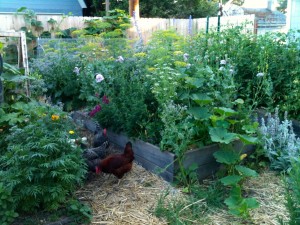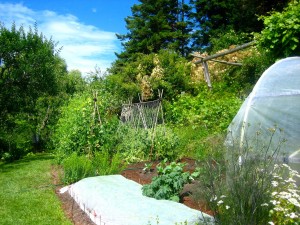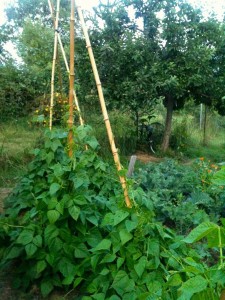Bringing together intensive edible landscape design and natural ecosystem design, permaculture can create highly productive urban lots, large or small. Picture walking out your back door to kitchen gardens close to the house. You harvest herbs and greens then collect eggs from the coop nearby. You pick berries planted along the fence of the chicken run and gather some mulberries from the tree that shades your birds. On the way out to the larger veggie garden, you gather beans vining on trellised structures you built with stalks harvested from the bamboo hedge, grab some cut flowers, thank all the buzzing pollinators and maybe – if the season is just right – pick goumi berries or plums to bring in. This is a snapshot of the possibilities of permaculture in a small city backyard.
So what is permaculture exactly? Bill Mollison, the founding father of the movement, stated it best: “Permaculture is a design system for creating sustainable human environments.” The word is a combination of “permanent” and “agriculture” or “culture.” The aim is to create a space that provides us things like food, fuel and fiber while still functioning at least somewhat like a healthy ecosystem.

With permaculture, the integration of trees, shrubs, medicinals, herbs, food plants, and animals is very intentional and there is no “waste” – the ideal is a tightly woven, closed-loop system. Each plant in the garden has multiple uses and many are paired with each other to create guilds, or small plant communities, that provide mulch or nutrients to increase the success of the group. Animals in the system also support multiple functions. Chickens are a great example – not only do they provide eggs and meat, but they eat lots of bugs and create valuable manure for improving compost and enriching soil. Fruit trees provide shade and some varieties do well trained along fences in small yards. Other plants may fix nitrogen, enrich soil or provide habitat for pollinators and beneficial insects that are eager to consume pesky plant pests.
Choosing a diverse palette of native plants and plants adapted to similar climates is also key in reducing pest problems and minimizing water needs. Patterning plantings off of natural woodland ecosystems allows for varying layers of food crops from ground covers to large fruit trees – a food forest. Permaculture design breaks the yard into zones based on frequency of visits. Zones closest to the house contain plants and animals that we go to most often. Time spent out in the permaculture yard is efficient and easy to work in.
Five Steps to a Permaculture Yard
Permaculture has so much to offer the home gardener. One of the most important permaculture mantras is “start ever so small, right from your doorstep.” Work with what you have and keep a few things in mind as you start your design process.

1. Thoughtful observation: Know your landscape. Observe your yard and really think about what works and what doesn’t work. Create a simple map of your yard. Record details: How much sun do you get? Is your yard north or south facing? Are there shady and wet areas or is your soil dry and sandy? Do you have animals? Do you have fences? A lawn or garden space? What do you want from the final product? Food? Shade? A space for gatherings? All of these? Pay close attention to your pathways. Are they hardscape paths? Do you use them or have you created your own? How do you move through your space? How does it change with the seasons? And so on. Keeping a record is an invaluable tool as you plan changes along the way.
2. Organize in zones: Location, location, location! Is this just true for everything? Place elements that you use and visit most frequently in the most accessible places. Think of that kitchen garden close to the house for items you can quickly harvest throughout the year.
3. Work with nature, not against it: Utilize the type of yard you have. The nuances of your yard give unique opportunities for designing. If an area is shady, sunny, dry, or near a structure, use that to your advantage.
4. Pay attention to edges: Edges are dynamic places in the yard. These areas, like along a fence, might hold more water or capture debris, create a microclimate, produce more enriched soil or something altogether different. Notice them – you may want more edge in your yard.
5. Build healthy soil: Compost those kitchen scraps, yard waste and animal manures. You will never regret adding these nutrients to your soils. Become a master composter! Start a worm bin! Do it! There is just no good excuse not to.
Most importantly, as with anything, have fun. There are lots of resources and knowledgeable people in our area. Once you start searching for permaculture information you will find it everywhere.

Local Permaculture Resources
- Spokanepermaculture.org is an active group right here in Spokane
- Inlandnorthwestpermaculture.com is a clearing house of local permaculturists and events.
- Michael Pilarski will be holding a workshop at the Heart Song retreat in Tumtum, Wash. – see inlandnorthwestpermaculture.com for more info. // (Beth Mort)













